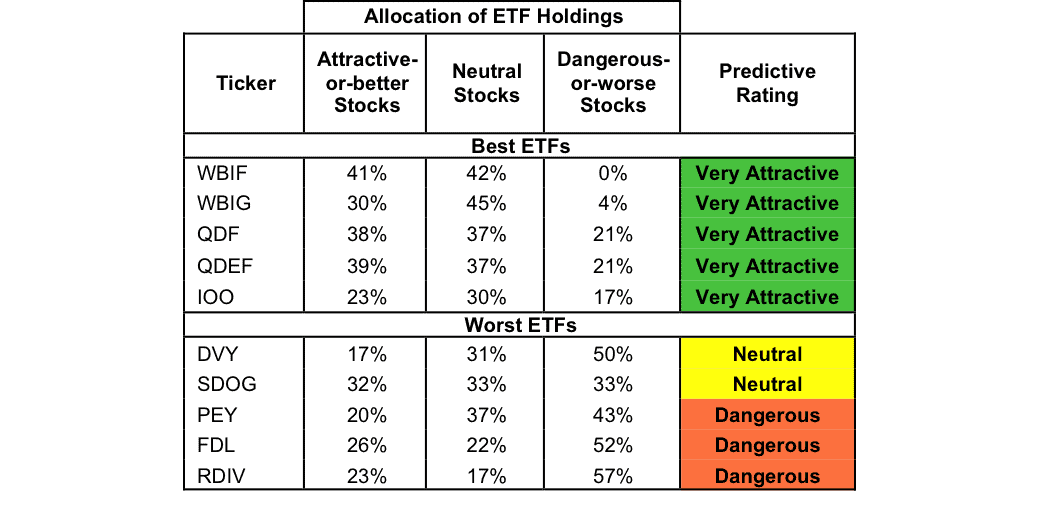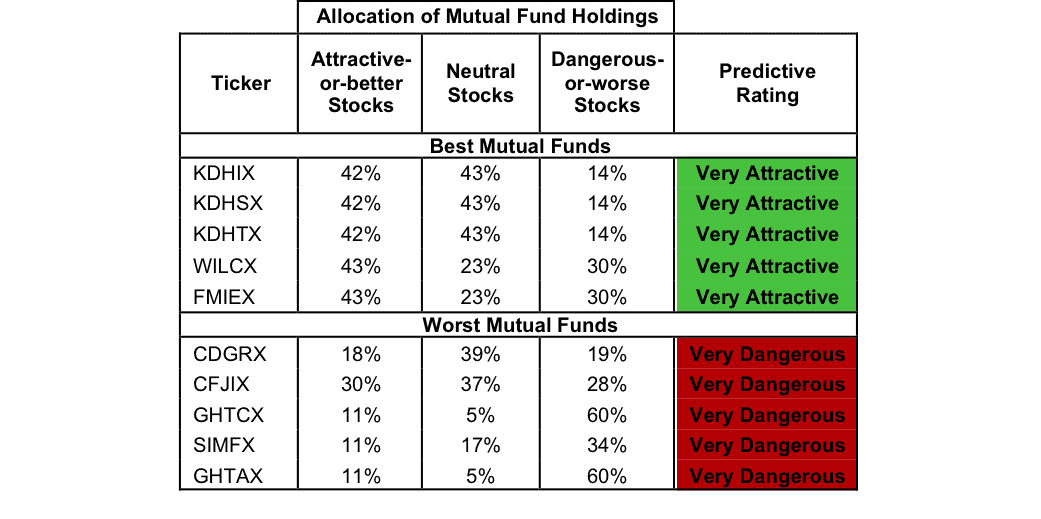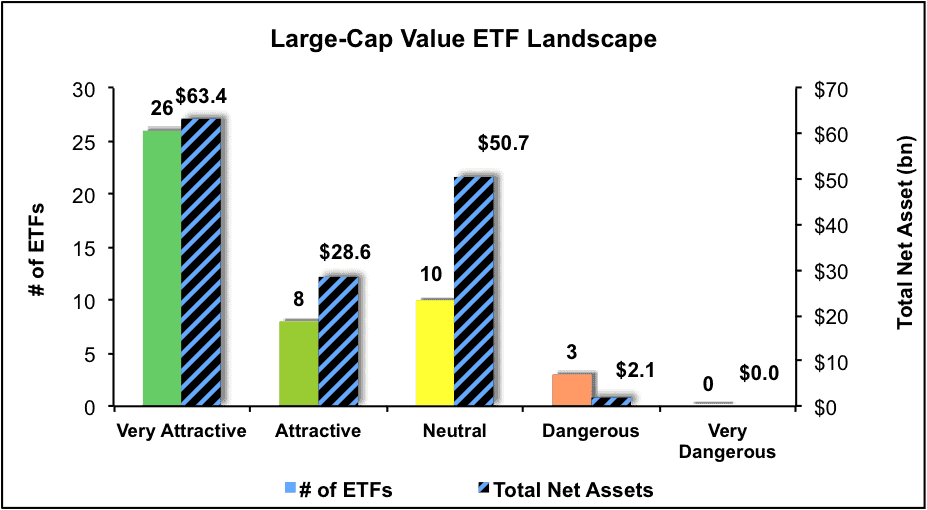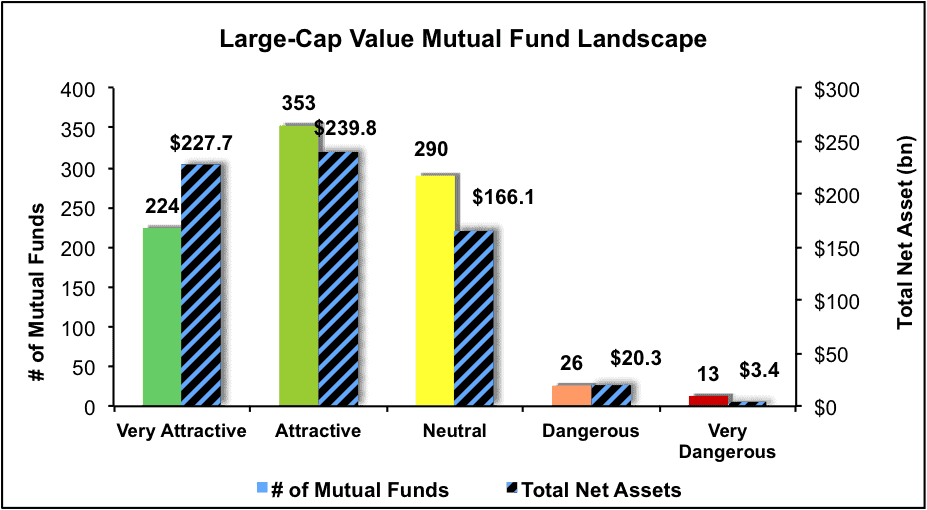The Large Cap Value style ranks first out of the twelve fund styles as detailed in our 2Q16 Style Ratings for ETFs and Mutual Funds report. Last quarter, the Large Cap Value style ranked second. It gets our Attractive rating, which is based on aggregation of ratings of 47 ETFs and 906 mutual funds in the Large Cap Value style as of April 29, 2016. See a recap of our 1Q16 Style Ratings here.
Figures 1 and 2 show the five best and worst rated ETFs and mutual funds in the style. Not all Large Cap Value style ETFs and mutual funds are created the same. The number of holdings varies widely (from 17 to 1020). This variation creates drastically different investment implications and, therefore, ratings.
Investors seeking exposure to the Large Cap Value style should buy one of the Attractive-or-better rated ETFs or mutual funds from Figures 1 and 2.
Figure 1: ETFs with the Best & Worst Ratings – Top 5
* Best ETFs exclude ETFs with TNAs less than $100 million for inadequate liquidity.
Sources: New Constructs, LLC and company filings
First Trust NASDAQ Rising Dividend Achievers ETF (RDVY) and FlexShares Quality Dividend Dynamic Index Fund (QDYN) are excluded from Figure 1 because their total net assets (TNA) are below $100 million and do not meet our liquidity minimums.
Figure 2: Mutual Funds with the Best & Worst Ratings – Top 5
* Best mutual funds exclude funds with TNAs less than $100 million for inadequate liquidity.
Sources: New Constructs, LLC and company filings
TS&W Equity Portfolio (TSWEX), Legg Mason BW Dynamic Large Cap Value (LMBGX, LMBEX), and Aston/Cornerstone Large Cap Value Fund (AAVIX) are excluded from Figure 2 because their total net assets (TNA) are below $100 million and do not meet our liquidity minimums.
Absolute Shares WBI Tactical LCV Shares (WBIF) is the top-rated Large Cap Value ETF and Deutsche CROCI Equity Dividend Fund (KDHIX) is the top-rated Large Cap Value mutual fund. Both earn a Very Attractive rating.
Oppenheimer Ultra Dividend Revenue ETF (RDIV) is the worst rated Large Cap Value ETF and Good Harbor Tactical Equity Income Fund (GHTAX) is the worst rated Large Cap Value mutual fund. RDIV earns a Dangerous rating and GHTAX earns a Very Dangerous rating.
The Progressive Corp (PGR: $33/share) is one of our favorite stocks held by WBIF and earns an Attractive rating. Since 1998, Progressive has grown after-tax profit (NOPAT) by 6% compounded annually. The company consistently earns a double-digit return on invested capital (ROIC) and currently earns a top-quintile 19%. Progressive has also generated a cumulative $3.9 billion in free cash flow over the past five years. Despite the long-term track record, PGR still presents a buying opportunity for true value investors. At its current price of $33/share, PGR has a price-to-economic book value (PEBV) ratio of 1.1. This ratio means that the market expects Progressive’s NOPAT to only increase by 10% over its remaining corporate life. If Progressive can grow NOPAT by just 5% compounded annually over the next decade, the stock is worth $46/share today – a 39% upside.
CenturyLink (CTL: $31/share) remains one of our least favorite stocks held by RDIV and earns a Dangerous rating. CenturyLink was placed in the Danger Zone in February 2015. CenturyLink has failed to generate positive economic earnings in any year of our model, which dates back to 1998. Even worse, over the past decade, CTL’s economic earnings have declined from -$152 million to -$1.2 billion. CenturyLink has never earned a ROIC above 7% and currently earns a bottom-quintile 4%. Despite over a decade of value destruction, CTL is still priced for significant growth. To justify its current price of $31/share, CenturyLink must grow NOPAT by 10% compounded annually for the next 11 years. These expectations seem overly optimistic and leave CTL with significant downside risk.
Figures 3 and 4 show the rating landscape of all Large Cap Value ETFs and mutual funds.
Figure 3: Separating the Best ETFs From the Worst Funds
Sources: New Constructs, LLC and company filings
Figure 4: Separating the Best Mutual Funds From the Worst Funds
Sources: New Constructs, LLC and company filings
Disclosure: David Trainer and Kyle Guske II receive no compensation to write about any specific stock, style, or theme.



